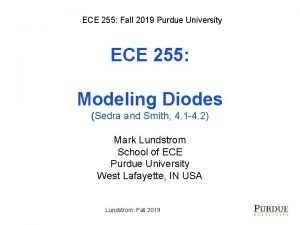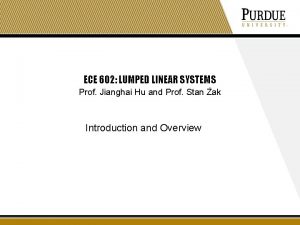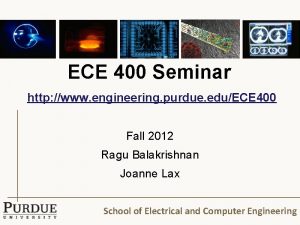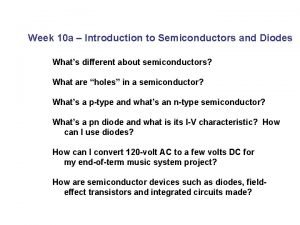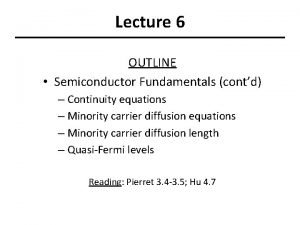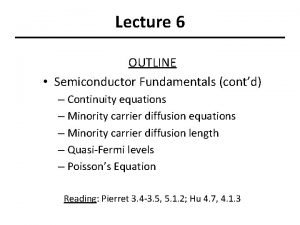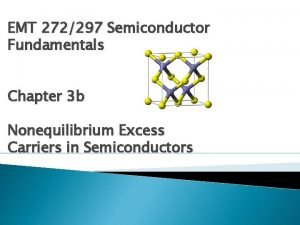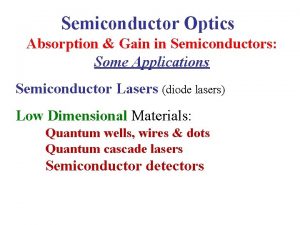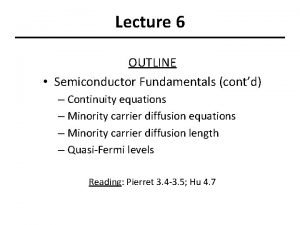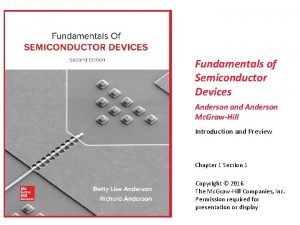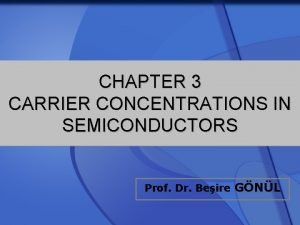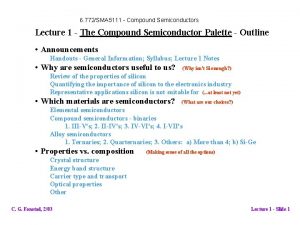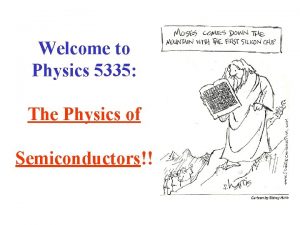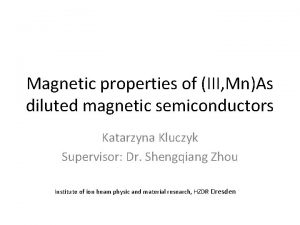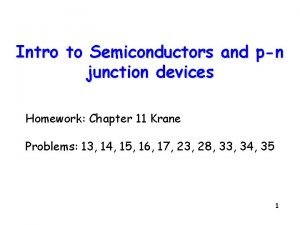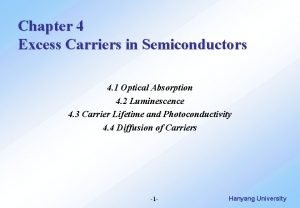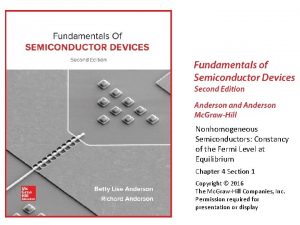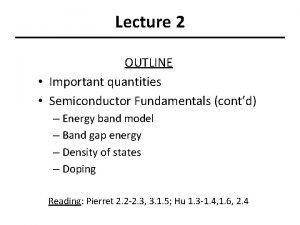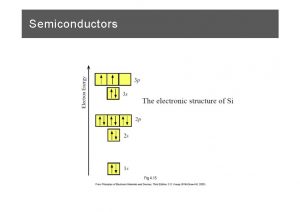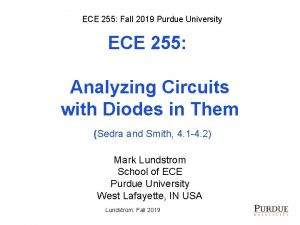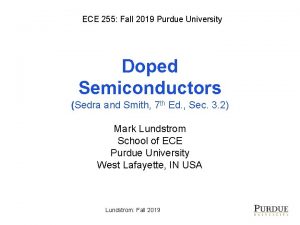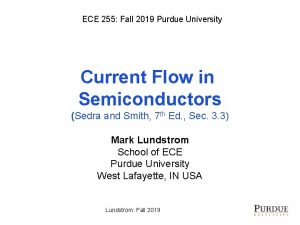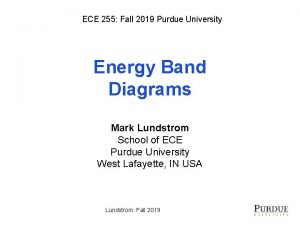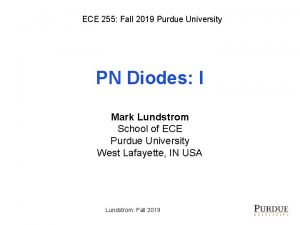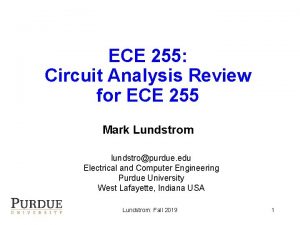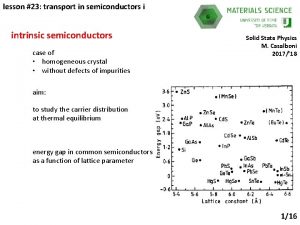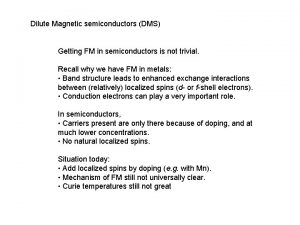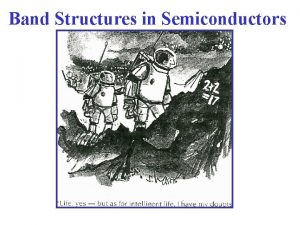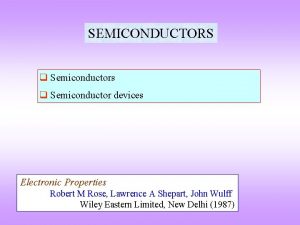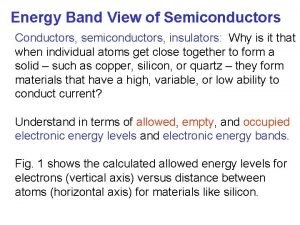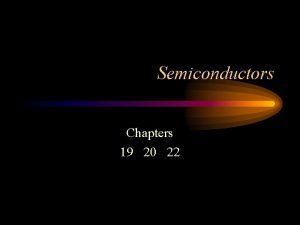ECE 255 Fall 2019 Purdue University Intrinsic Semiconductors





























- Slides: 29

ECE 255: Fall 2019 Purdue University Intrinsic Semiconductors (Sedra and Smith, 7 th Ed. , Sec. 3. 1) Mark Lundstrom School of ECE Purdue University West Lafayette, IN USA Lundstrom: Fall 2019 1

Intrinsic semiconductors 1) 2) 3) 4) Energy levels of atoms Energy bands in crystals Intrinsic carrier concentration Insulators, metals, and semiconductors Lundstrom: Fall 2019 2

The hydrogen atom electron (- charge) Coulomb force proton (+ charge) Electrons reside in “orbitals” https: //en. wikipedia. org/wiki/Hydrogen_atom Lundstrom: Fall 2019 3

Quantization of energy levels Hydrogen (Bohr) atom + 4

Joules vs. electron volts Lundstrom: Fall 2019 5

Orbitals n: principle quantum number l: angular momentum quantum number m: magnetic quantum number Lundstrom: Fall 2019 6

Silicon atom energy levels Si atom (At. no. 14) 4 s 0 energy 3 p 6 3 s 2 2 p 6 2 s 2 1 s 2 Lundstrom: Fall 2019 7

Valence vs. core levels Si atom (At. no. 14) 4 s 0 energy 3 p 6 4 valence electrons 8 valence states 3 s 2 2 p 6 “core levels” 2 s 2 1 s 2 Lundstrom: Fall 2019 8

Silicon energy levels / energy bands • Only the valence states are of interest to us. • Each Si atom has 4 valence electrons and 4 nearest neighbors. • The 8 valence states give rise to 8 Natoms states per cm 3 in the solid. • But the interaction of the electron wavefunctions alters the discrete energy levels of the isolated Si atoms. Å Lundstrom: Fall 2019 9

Bonding (cartoon) shared valence electrons atom plus core levels Lundstrom: Fall 2019 10

Silicon energy levels energy bands Si crystal Si atom (At. no. 14) energy “localized states” 3 p 6 3 s 2 “de-localized states” conduction “band” all states empty “forbidden gap” valence “band” Lundstrom: Fall 2019 all states full 11

Aside: Ideal Gas Maxwellian velocity distribution V: volume P: pressure T: temperature N: number of atoms 12

Bonding (cartoon T > 0 K) shared valence electron atom plus core levels Lundstrom: Fall 2019 13

Joules and electron volts We should do our calculations in SI (MKS) units, but it is convenient to express energies in electron volts, which is not a proper SI unit. Electron volts should be converted to Joules before using them in calculations. 14 Lundstrom: Fall 2019

Semiconductor vocabulary Conduction band Valence band Forbidden gap (band gap) Average thermal energy: 3 k. BT/2 Probability of particle with energy, E: f(E) ~ exp[-E/k. BT] Lundstrom: Fall 2019 15

Electrons and holes in semiconductors electron in valence band 1) Electrons in the conduction can move 2) Holes in the valence band can also move 3) Electrons and holes can recombine Lundstrom: Fall 2019 16

Energy band view T > 0 K Si crystal A few states full conduction “band” • • • “forbidden gap” n 0 = p 0 = ni in an intrinsic semiconductor • • • valence “band” Lundstrom: Fall 2019 A few states empty 17

“Energy band diagrams” “intrinsic semiconductor” • • • “forbidden gap” energy conduction “band” • • • • • • • valence “band” position Lundstrom: Fall 2019 18

Two key parameters Intrinsic Si 19 Lundstrom: Fall 2019

Is 1010 a big number? 20 Lundstrom: Fall 2019

Semiconductor vocabulary Conduction band Valence band Forbidden gap (band gap) Average thermal energy: 3 k. BT/2 Probability of particle with energy, E: f(E) ~ exp[-E/k. BT] Electrons (in the conduction band) Holes (in the valence band) Intrinsic carrier concentration, ni(EG, T) 21

Metals insulators and semiconductors Metals: conduct electricity (and heat) well. Insulators: don’t conduct electricity well usually don’t conduct heat well Semiconductors: in-between, but their properties can be controlled Lundstrom: Fall 2019 22

Insulators Metals Semiconductors empty states filled states Lundstrom: Fall 2019 23

Semiconductors column IV http: //en. wikipedia. org/wiki/Periodic_table Lundstrom: Fall 2019 24

III-V semiconductors Col. III V http: //en. wikipedia. org/wiki/Periodic_table Lundstrom: Fall 2019 25

II-VI semiconductors Col. II Col. VI http: //en. wikipedia. org/wiki/Periodic_table Lundstrom: Fall 2019 26

Summary The localized energy levels in isolated atoms become delocalized energy bands in a solid. Everything happens very near the top of the valence band very near the bottom of the conduction band. The electrical current in a semiconductor is carried by electrons in the conduction band by holes in the valence band. The band gap and intrinsic carrier concentration are two key parameters for semiconductors. Lundstrom: Fall 2019 27

Semiconductor vocabulary 1) Conduction band 2) Valence band 3) Forbidden gap (band gap) 4) Average thermal energy: 3 k. BT/2 5) Probability of particle with energy, E: f(E) ~ exp[-E/k. BT] 6) Electrons (in the conduction band) 7) Holes (in the valence band) 8) Intrinsic carrier concentration, ni(EG, T) 9) Insulator / metal / semiconductor 10) Column IV / III-V / II-VI semiconductors 28

Intrinsic semiconductors 1) 2) 3) 4) Energy levels of atoms Energy bands in crystals Intrinsic carrier concentration Insulators, metals, and semiconductors Lundstrom: Fall 2019 29
 255, 255, 255
255, 255, 255 Ece 255 purdue
Ece 255 purdue Goremote purdue
Goremote purdue Purdue medical physics
Purdue medical physics Ece 570 purdue
Ece 570 purdue Ee 170 purdue
Ee 170 purdue Introduction to semiconductors
Introduction to semiconductors Direct and indirect band gap semiconductors
Direct and indirect band gap semiconductors Semiconductor industry association sia
Semiconductor industry association sia Semiconductor technology roadmap
Semiconductor technology roadmap Continuity equation electronics
Continuity equation electronics Continuity equation semiconductor
Continuity equation semiconductor Equation of continuity in semiconductors
Equation of continuity in semiconductors Atomic layer deposition for semiconductors
Atomic layer deposition for semiconductors Bahan semikonduktor
Bahan semikonduktor Equipement used for making semiconductors
Equipement used for making semiconductors Semiconductor
Semiconductor Continuity equation derivation in semiconductors
Continuity equation derivation in semiconductors Fundamentals of semiconductor devices anderson pdf
Fundamentals of semiconductor devices anderson pdf Acceptor concentration formula
Acceptor concentration formula Quarternaries
Quarternaries The physics of semiconductors
The physics of semiconductors σsk
σsk Semiconductor junction devices
Semiconductor junction devices Quasi fermi level
Quasi fermi level International roadmap for semiconductors
International roadmap for semiconductors Bank of america semiconductors
Bank of america semiconductors Semiconductor and its types
Semiconductor and its types Whats semiconductor
Whats semiconductor Semiconductors band gap
Semiconductors band gap

